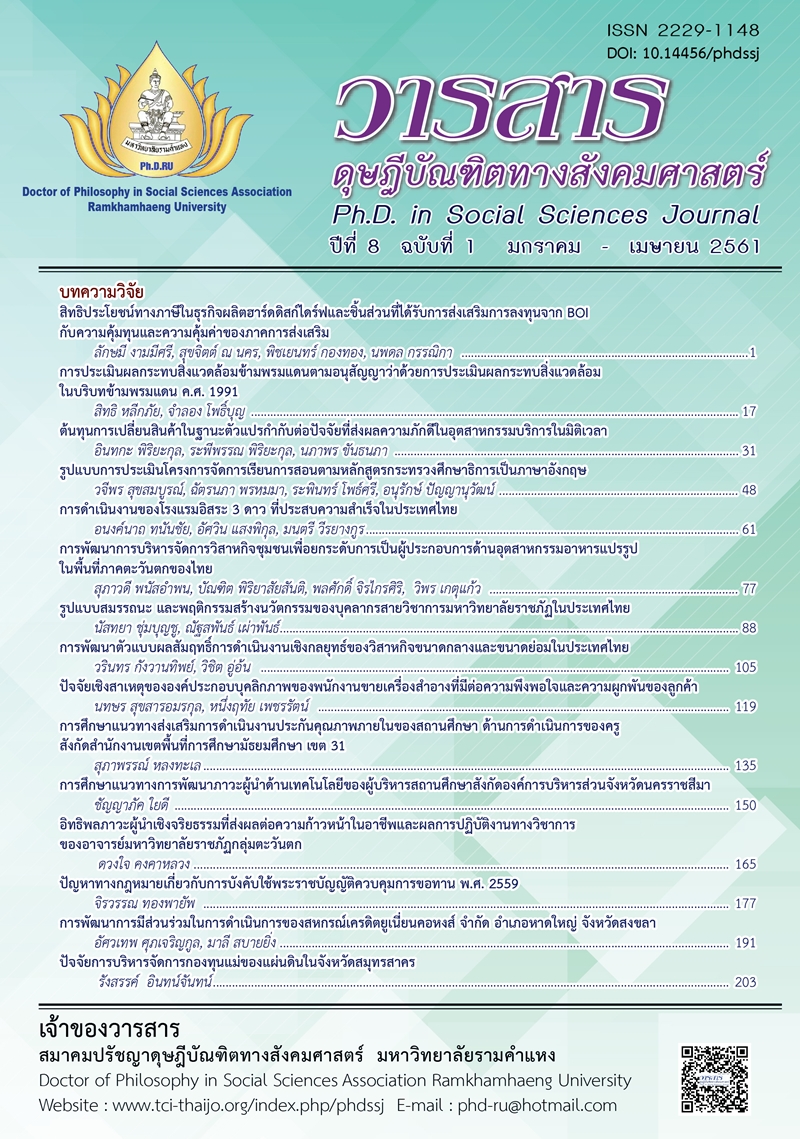TRANSBOUNDARY ENVIRONMENTAL IMPACT ASSESSMENT UNDER 1991 CONVENTION ON ENVIRONMENTAL IMPACT ASSESSMENT IN A TRANSBOUNDARY CONTEXT
Main Article Content
Abstract
The objectives of this study are to study the system of transboundary environmental impact assessment (TEIA) under the Convention on Environmental Impact Assessment in a Transboundary Context 1991 (Espoo Convention) and to study the practical application of TEIA under the Espoo Convention. This study is qualitative research. This study uses the method of context analysis and logical descriptive analysis of secondary data gathered from various sources i.e. textbooks, academic articles, researches, important documents, arbitration awards and court judgements.
The Espoo Convention is an agreement specifying procedures for the conduct of TEIA between parties in broad terms. In the practical application of Espoo Convention, parties are required to agree in further details especially on matters not specified in the Espoo Convention but necessary for the successful conduct of TEIA. The United Nations Economic Commission for Europe has issued a Guidance on the Practical Application of the Espoo Convention to be used as a guideline for the conclusion of bilateral or multilateral agreement for the practical application of Espoo Convention. This study has also investigated one of implementation agreements between parties of the Espoo Convention that is the Agreement between the Government of the Federal Republic of Germany and the Government of the Republic of Poland on the Implementation of the Convention on Environmental Impact Assessment in a Transboundary Context of 25 February 1991 for the better understanding about the conclusion of a bilateral agreement for the implementation of Espoo Convention.
Article Details
Academic articles, research articles, and book reviews in the Ph.D. in Social Sciences Journal are author’s opinions, and not the publisher’s, and is not the responsibility of the Ph.D. in Social Sciences Journal Philosophy Association, Ramkhamhaeng University. (In the case that research is done on human, the researcher has to be trained in Ethics for Doing Research on Human Training and has to produce the evidence of the training).
References
Birnie, P., & Boyle, A. (2002). International law and the environment (2nd ed). Oxford, England: Oxford University Press.
Craik, N. (2008). The international law of environmental impact assessment. Cambridge, MA: Cambridge University Press.
Department of ASEAN Affairs.(2013). ASEAN mini book (4th ed.). Bangkok: Author. [In Thai]
Ebbesson, J. (1999). Innovative elements and expected effectiveness of the 1991 EIA convention. Environmental Impact Assessment Review, 19(1), 47-55.
Economic Commission for Europe. (2006). Guidance on the practical application of the Espoo convention. Retrieved October 13, 2016, from https://www.unece.org/env/eia/guidance/practical.html
Economic Commission for Europe. (2016). Bilateral and multilateral agreements. Retrieved October 19, 2016, from https://www.unece.org/env/eia/resources/agreements.html
Malanczuk, P. (1997). Akehurst’s modern introduction to international law (7th ed.). London: Routledge.
Piwawatthanaphanit, P. (2016). Private international law (2nd ed.). Bangkok: Thammasat University Press. [In Thai]
Pollution Control Department. (2004). PCD and UN sustainable development. Retrieved December 23, 2012, form https://www.pcd.go.th/info_serv/en_pol_sustainable.htm [In Thai]
Popiel, B. (1995). From customary law to environmental impact assessment: A new approach to avoiding transboundary environmental damage between Canada and the United States, 22 B.C. Envtl. Aff. L. Rev. 447.
Sa Swangjang, K. (2006). Environmental impact assessment procedure (2nd ed.). Nakhon Pathom: Silpakorn University Press. [In Thai]
Sisunthon, C. (2011). Public international law 1 (9th ed.). Bangkok: Winyuchon. [In Thai]


